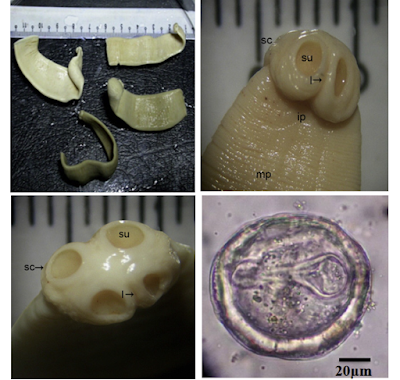For example lemurs and capuchin monkeys are known to smear millipede juice on themselves as a mosquito repellent. But there is no perfect defence and the millipede have some adversaries that are not deterred by its defensive secretion, some of which are phorid flies in the Myriophora genus - which are specialised millipede hunters.
 |
| a) Myriophora alexandrae laying an egg at the base of a millipede's antenna, (b) Myriophora communis (insert: ovipositor), c) Millipede excreting defensive fluid while a Myriophora harwoodi feeds on it, (d) Myriophora maggot and dead host Photos from Fig. 2 of this paper |
With so many different species of phorids out there, perhaps it is not surprising that they have evolved to target a wide range of terrestrial invertebrates - and some of them specialised in hunting millipedes, undeterred by their chemical defences. So how do Myriophora flies track down their millipede hosts? To find out, a group of researchers conducted a series of experiments at a research station in Costa Rica to determine what it is about millipedes that these flies find so attractive. They wanted to figure out whether it is the defensive juices secreted by the millipedes or the sight of the millipedes themselves. So they collected some millipedes, kept them for a few days to ensure they're parasitoid free to start with, and used them to set up an experiment in luring phorid flies.
They end up presenting the flies with the following: (1) millipede juice dabbed on pieces of paper (which they obtain by lightly zapping the millipedes), (2) dead millipede smeared in millipede juice, and (3) millipedes which have been cleared of any millipede juice by zapping them until they run out of defensive secretions.
They found that the Myriophora flies were rather attracted to paper cards dabbed with millipede juice and millipedes that were smeared with their own defensive secretions. In contrast, the flies completely ignored perfectly intact millipedes that were completely juiced out. So it seems that the scent of a millipede is far more important than the sight of one for these flies.
So not only are Myriphora not deterred by the millipede's noxious chemicals, they are actually attracted to it. But millipede juice is a complex chemical cocktail - which is the exact compound that the flies are homing in on? After further analysis, the researchers determined that the compound in millipede juice most responsible for attracted these parasitoids is a chemical called 2-methoxy-3-methyl-1,4-benzoquinone. That alone was enough to bring the flies to the yard. But when that is combined with another compound found in millipede juice called 2-methyl-1,4-benzoquinone, this cocktail was three times more attractive to Myriophora flies than that first compound by itself.
But a millipede is a well-protected target - even if you can get past its noxious secretions, it also has some formidable armour platings. But there are gaps in its armoured segments and Myriophora has a specialist weapon to exploit those gaps. This parasitoid fly has an ovipositor which is shaped somewhat like a thin stiletto - when it lands on a millipede, Myriophora stabs its ovipositor at spots like the base of the antenna, the gap between the head and the rest of the body, the vulnerable underbelly of the body segment, or between the plates covering the millipede's butt.
The parasitoid sticks its ovipositor between those gaps in the millipede's armour, and delivers a deadly payload in the form of an egg. Once the egg hatches inside the millipede, the newborn maggot has a hearty appetite and a growth rate to match. Within five days, it will finish cleaning out the millipede host from the inside, leaving behind only an empty husk and the millipede's hindgut. The maggot will then crawl from its host's empty corpse to pupate and eventually emerge as an adult fly, ready to bring up a new generation of millipede-wreckers
So for the millipedes, while those defensive cocktails are great for fending off everything else, there is no perfect defence - the very thing that protects it against some many predators is also the very thing that brings in parasitoid flies that will eat them alive.
Reference:
Hash, J. M., Millar, J. G., Heraty, J. M., Harwood, J. F., & Brown, B. V. (2017). Millipede Defensive Compounds Are a Double-Edged Sword: Natural History of the Millipede-Parasitic Genus Myriophora Brown (Diptera: Phoridae). Journal of Chemical Ecology 43: 198-206.
